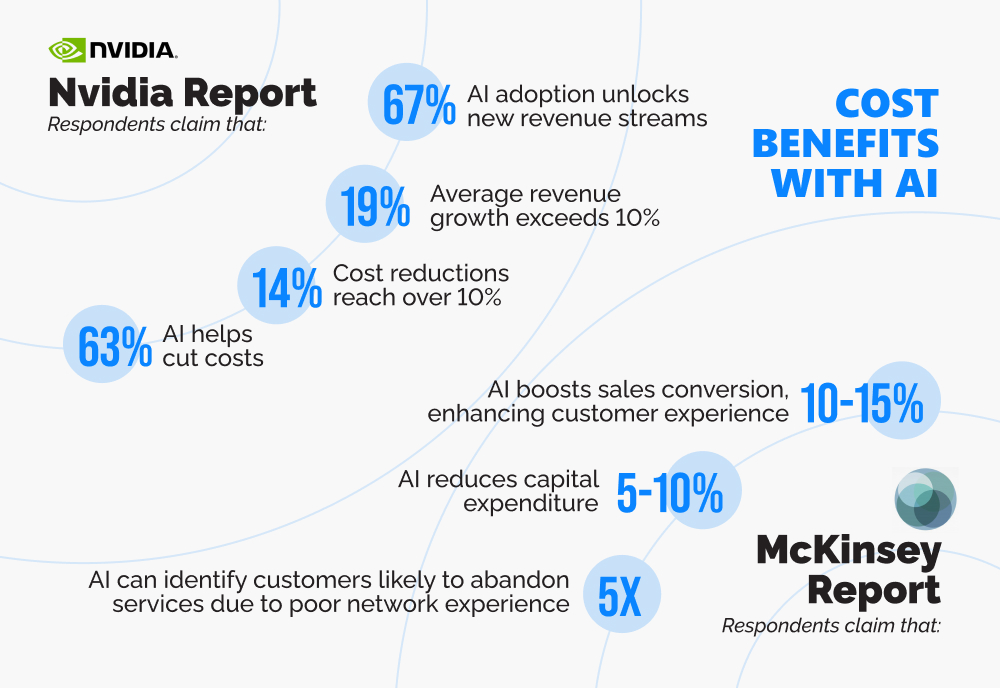As the world witnesses more technological innovation, employees and customers wrestle with more complex challenges. Mobile, fixed, and cable company staff deal with a flood of inquiries from various channels. They must match the right clues to customer requests quickly and empathetically, as their paychecks depend on it. Meanwhile, corporate teams at HQ grapple with unstructured data, seeking hidden insights.
Feeling the pressure? How can you adapt to deliver a hassle-free yet innovative experience for your team and clients? Could the adoption of AI in telecom become the solution to telecom challenges? Let’s find the answers in today’s article!

written by:
Alexey Sliborsky
Solution Architect
As the world witnesses more technological innovation, employees and customers wrestle with more complex challenges. Mobile, fixed, and cable company staff deal with a flood of inquiries from various channels. They must match the right clues to customer requests quickly and empathetically, as their paychecks depend on it. Meanwhile, corporate teams at HQ grapple with unstructured data, seeking hidden insights.
Feeling the pressure? How can you adapt to deliver a hassle-free yet innovative experience for your team and clients? Could the adoption of AI in telecom become the solution to telecom challenges? Let’s find the answers in today’s article!
Contents
Current State of AI in the Telecommunication Market
The telecom industry is no stranger to sharp technological advances. We’re witnessing the push towards innovation with AI taking center stage. The primary driver? The need to stay competitive and cater to the shifting demands of telecom operators and their customers.
The industry used to seem like an impenetrable fortress, rarely undergoing renovation. Connectivity, internet, and mobile reception were the mainstays. Periodic speed upgrades from 4G to 5G marked the extent of innovation. This approach sufficed for a while. But with AI’s arrival, everything has changed.
Today, telecom operators need to broaden their range of services. They should adapt packages for each customer, introducing targeted solutions for specific segments. Exceptional and personalized customer service has become the hallmark of any reputable telco. Advanced networking hardware and efficient network management are key to this transformation.
How’s the adaptation going? Let’s explore the current state and key prospects for artificial intelligence in the telecommunication market:
AI in Telecom: Challenges to Solve
The future of AI in the telecom industry looks promising. This field has amassed mature data with many challenges. Yet, the latest developments can effectively combat them. Investing in AI can turn these obstacles into growth and innovation opportunities. Let’s take a broader perspective on the key telecom challenges that AI solutions can solve.
Challenge #1: High Maintenance Costs
McKinsey notes that field and service operations occupy a large part of carriers’ operating budgets — between 60% and 70%. The reason?
Telecom companies manage a wild range of hardware. Routers, gateways, switches — every piece of equipment is integral to network functionality. But each calls for constant monitoring to prevent failures. High-quality service demands regular updates, troubleshooting, and replacing outdated or faulty components.
The flip side is the complexity and scope of these tasks. They demand significant financial investment and manpower. The result is immense operational costs that can strain budgets.
What adds to the financial burden? The rapid pace of technological advancement. As new technologies emerge, telecom companies must modernize their infrastructure to stay competitive. This entails purchasing new hardware and integrating it into the existing network. Neglecting this results in more frequent breakdowns in legacy systems, escalating maintenance costs.
The geographical spread of telecom infrastructure adds another layer of complexity. Networks often cover vast areas, including remote and difficult-to-access locations. This demands a dispersed maintenance team and precise planning for timely upkeep. What does this mean for you? That’s right, more expenses.
Challenge #2: Managing Big Data
In the telecommunications industry, data is among the most valuable assets. Yet, the practical value of this information rests on how you wield it and what insights you glean from it.
Telcos store big data. This includes network activity, operational data, customer information, device details, and location data. With so many users and constant data generation, the amount of information is mind-boggling.
What’s the problem with big data besides its sheer volume?
- Diverse nature. Telecom companies handle information on different media and in various formats. This includes structured billing data, unstructured customer interaction data, and semi-structured device data. Managing such diverse datasets calls for advanced data integration techniques and storage solutions.
- Silos. Data is scattered across several systems, making it a challenge to get a unified view. This fragmentation complicates data consolidation and integration, often hiding critical details.
- Quality. Outdated or inaccurate data can cause faulty analysis and ill-considered decisions. Monitoring data accuracy, consistency, and timeliness is an ongoing effort that must adhere to sound data governance practices.
- Processing. You need to analyze data in real-time to respond promptly to network issues, customer requests, and operational anomalies. This demands high computing power and robust analytical tools.
- Intensity. Managing big data is resource-intensive, both technological and labor. From building data infrastructure to maintaining data quality and security, the demands are high. This can strain your resources and negatively impact your ability to use big data.
Challenge #3: Insufficient Response to Customer Pains
When everyone and everything is connected, even a minor glitch can become a nightmare for a telecom company. If connectivity fails, users flood service providers with their grievances. As user numbers and requests grow, customer service quality drops. This leads to long waits, unresolved issues, and impersonal interactions.
Customers want fast, efficient service. But telecom companies struggle to meet these expectations due to high call volumes and limited resources. Long wait times breed frustration, and unresolved queries undermine trust and loyalty. This impacts customer satisfaction and tarnishes the company’s reputation.
Impersonal interactions are a big problem in telecom, where personal touch matters. Customers often feel like just another number in the queue, not valued clients. Repeated failed interactions lead to a disconnect between the company and its customers, worsening dissatisfaction.
Statistics back this up. According to Zendesk, about 80% of customers would rather do business with a competitor after more than one bad experience.
Challenge #4: Security and Data Leakage
Telecom fraud is a grave and evolving challenge for the industry, driven by rapidly advancing technology and sophisticated fraud techniques. Forbes reports that global revenue losses from criminal activity have reached 2.2%, or $40B.
Here are some of the major threats telecom providers have to fight:
- International Revenue Sharing Fraud (IRSF). Scammers make unauthorized calls to premium numbers, causing significant financial losses for businesses.
- Subscription fraud. Criminals use stolen or fake identities to get telecom services, leaving providers with unpaid bills and lost revenue.
- SIM swap fraud. Fraudsters gain control over a victim’s phone number by tricking the service provider into transferring the number to a new SIM card. This allows them to intercept calls and messages, often resulting in unauthorized access to bank accounts and sensitive information.
- Wangiri Scam. Criminals make short missed calls, prompting victims to call back to premium numbers with high rates. The result is unexpected charges for the victims.
- CLI spoofing. It involves altering the caller ID to hide the true identity of the caller, typically used in phishing attacks.
Why do these situations persist in telecom?
- The volume and complexity of data make it hard to analyze and track fraudulent activities in real-time;
- Evolving fraud techniques, which require constant updates and improvements to threat detection systems;
- Integrations with legacy systems that aren’t equipped to handle modern fraud detection techniques.
Benefits of AI in Telco
Do any of the obstacles listed above relate to your situation? Even if you’re lucky enough to avoid them, taking precautions is always wise. Consider AI applications that promise to help you overcome or prevent these problems.
Efficient Network Management
Adopting AI for network management equips the telecommunications sector with powerful tools to improve network performance and proactively troubleshoot emerging issues. Advanced AI algorithms help communications service providers (CSPs) detect and predict network anomalies before they affect customers.
For instance, a well-built AI system can forecast congestion by analyzing network traffic patterns across regions and time zones. This allows CSPs to reroute traffic in advance and prevent outages.
A prime example of AI’s potential is in 5G network planning and management. Since its rollout began in 2019, 5G aimed to cover about 80% of the world’s population by 2029 (ericsson.com). Artificial intelligence in telecom can assist in building self-optimizing networks (SONs) that adapt to changing conditions and demands. Thus, it will contribute to the rapid growth and complexity of 5G infrastructure.
Profitability of Base Stations
Aside from new technologies, the industry is experiencing a strong demand for high-speed mobile data services and the rapid expansion of mobile networks. This calls for the early modernization of telecom base stations. The deployment of 5G technology has further increased the need to improve their capacity and coverage.
What is the crux of the problem? The high cost of base station equipment and the demand for properly trained specialists to deploy and maintain these systems. This is a perfect match for AI-based tools. How exactly they can help:
- Select optimal locations for base stations;
- Control their energy consumption, turning off or reducing power in underutilized areas and ramping up in high-traffic zones;
- Predict equipment failures;
- Dynamically adjust the load on base stations to distribute traffic evenly;
- Recommend real-time adjustments to optimize signal strength and coverage: tweaking antenna angles or adjusting power levels:
- Maintain peak performance of both single-band and multi-band base stations;
- Identify network faults and pinpoint their locations, granting faster response times and minimizing user impact.
Recent news from Samsung illustrates these use cases. The company has introduced AI-RAN Parameter Recommender, which automatically recommends optimal parameters for each base station environment.
Automated Fraud Detection
Telecom fraud has plagued the industry since its inception. Fortunately, AI-enabled tools now help carriers stay ahead of evolving fraud schemes. They provide network automation and ongoing monitoring to detect bots, prevent unauthorized access to customer data, and safeguard sensitive information.
When combined with IoT, data analytics, and cloud computing, AI tools excel in real-time network monitoring. They quickly spot system vulnerabilities, allowing CSPs to patch them, update encryption, and improve data storage methods and disaster recovery plans. This approach minimizes financial loss, protects reputation, and guarantees compliance with legal standards.
Cost Optimization
All these benefits culminate in one advantage that every business values the most — cost reduction. That’s where Intelligent Process Automation (IPA) comes into play. IPA uses AI, machine learning, cognitive automation, and computer vision. With them, lengthy procedures — invoicing, order management, and data processing — run much faster.
By using these technologies for automation, telecom companies gain several benefits at once:
- Increased operational efficiency;
- Optimized cost management;
- Minimized resource requirements;
- Reduced risk of human error.
When AI automates repetitive tasks, optimizes resources, minimizes downtime, and predicts traffic anomalies, all you’ll notice is lower operational costs and the desired profitability. Recent statistics only bolster these claims.
- 67% of respondents reported that AI adoption helped them unlock new revenue streams. 19% of them noted that their average revenue growth exceeded 10%.
- 63% of respondents said AI adoption helped them cut costs. 14% of them claimed the reductions reached more than 10%.
- AI-driven customer experience can identify customers up to 5 times more likely to abandon services in response to poor network quality;
- AI can identify opportunities to reduce capital expenditure by 5-10%;
- AI can help increase sales conversion by 10-15%, further driving up customer experiences.
AI Use Cases in Telecom
The pros of technology are in place. Then it’s time to explore what they yield in real life. Below is a table listing a few of the key global AI/ML use cases in telecom.
Use Case
Description
Example
Network Monitoring
AI can double the efficiency of network monitoring with ongoing analysis of traffic patterns, anomaly detection, and potential issue prediction.
In a telecom network, it identifies unusual spikes in traffic that may point to a security breach or hardware failure.
Predictive Maintenance
AI can act as an advanced maintenance technician who anticipates equipment failures and network outages before they happen. This reduces maintenance costs, optimizes infrastructure investments, and prolongs equipment lifespan.
AI analyzes data from network sensors to predict equipment failures. Then it generates alerts with details for the maintenance team to fix everything before it causes downtime.
Digital Twins
Digital twins are functional systems that model, operate, and optimize products and processes. In telecom, these tools also enable greater efficiency. Operators can use them to test scenarios and place assets within a 3D, realistic environment before making substantial investments in the physical world.
A telecom operator uses digital twins to test base station placements in a virtual city, analyzing signal coverage and interference to minimize costs and disruptions before investing.
Root Cause Analysis
ML models can predict new network faults based on historical data. This data includes customer calls, equipment types, trouble tickets, and firmware details. Using vendor-developed solutions, you can rely on experience from other networks to speed up fault detection. For operator-specific issues, rich data is essential for precise root cause detection.
The model finds a recurring problem with a specific firmware version across multiple networks. For unique faults on a particular operator’s network, it uses detailed data to identify the root cause, such as a rare hardware malfunction.
Cybersecurity Threat Detection
AI tools, like Precision AI by Palo Alto Networks, help telcos watch AI application usage, prevent data leakage, and block AI-generated phishing. This includes conversations and metadata used in creating custom GPTs. Businesses can now identify potential risks associated with data exposure, control overly free access to sensitive data, and boost security hygiene by guiding end users.
AI detects unusual usage of a custom GPT and flags it as potential phishing. The tool blocks suspicious activity to protect sensitive information.
*What do you think about AI in the entertainment industry? Is it a good pair? Read more in our blog post.
Red Flags for AI in Telecoms
While technological complexity and workforce adoption may seem major obstacles in your AI journey, other aspects also require your attention. Let’s explore the key factors for a successful and trouble-free AI implementation.
AI Hallucinations
These are incorrect or nonsensical outputs that generative AI produces. In 2024, the world has seen several notable slip-ups that AI hallucinations caused. In February, AirCanada was forced to cancel a mistaken discount offered by its chatbot. In May, Google revised its “AI Overviews” after its bot incorrectly claimed it was safe to eat rocks. In June, two lawyers were fined $5,000 after one of them admitted to using ChatGPT, which added fake citations to court documents.
While AI hallucinations tend to be infrequent, they are constant. The frequency rate ranges from units of percent (Vectara’s Hughes Hallucination Evaluation Model) to tens (National Library of Medicine). The best strategy here is to not rely on AI 100% and always double-check what it states as a fact. Your company’s reputation is at stake.
Ethical Concerns
Inclusivity, fairness, and bias concerns deserve special attention. Gen-AI, powered by machine learning algorithms, relies on data. If this data is low-quality, biased, or lacks inclusivity and ethics, your AI model may unintentionally perpetuate or amplify these issues.
To be ethical and avoid sensitive conflicts with users, you should check the information on which you train your LLM agent. By doing so, you will mitigate, if not avoid, misuse, abuse, hallucinations, and algorithmic bias.
Significant AI Investments and Tech Expertise
Adopting AI for telecom requires huge financial investments. As a telecom provider, you must decide whether to build your own AI model from scratch or to buy licenses for integration. Don’t forget the time and money spent on finding experienced specialists and bringing them on board.
You’ll have to choose an optimal route: get the necessary skills in-house by hiring more staff, or choose the outsourcing road and collaborate with a third-party vendor. Hiring and keeping professionals with AI expertise can be costly and competitive. As the hunger for smart technologies skyrockets, so does the price of talent. Companies must not only offer attractive packages but also create compelling environments to win over and retain these in-demand professionals.
Integration with Legacy Technologies
Even with technological advances, many network operators still rely on legacy systems. This further complicates AI integration. The process requires a separate strategy and significant changes to your IT architecture. The hassle of blending new AI technologies with legacy systems leads to compatibility issues, higher costs, and delays. Your team will master smooth data flow and maintain system stability during the transition. This takes careful planning and execution, translating to extra time and money.
Regulatory and Compliance Issues
As AI becomes more integrated into telecommunications, the focus on regulatory compliance intensifies. The Telecommunications Security Act 2021 in the UK, for example, sets strict requirements for telecom operators, including security measures and compliance monitoring. Navigating these regulations can be challenging, especially for companies outside their home country.
To stay compliant, you must understand the laws in the countries where you plan to offer AI services. Quickly adapting to new, evolving regulations will be equally beneficial. This may call for significant workflow changes, ongoing monitoring, and regular audits, which can drain resources and impact efficiency.
Telecom + AI: Success Stories from the Real World
Are you worried about the potential pitfalls of implementing AI? The telecom sector does have its share of challenges, but there’s promising news. The industry is full of success stories where leading companies have successfully passed all the tests and are now thriving with AI. These are some compelling examples:
Company
Goal
Solution
Orange S.A., a leading French multinational telecommunications corporation
Personalize customer interactions to boost satisfaction and loyalty; optimize customer support to reduce wait times; use customer data to refine service quality.
A 24/7 chatbot helps orchestrate instant and personalized support. AI algorithms optimize the support process, while advanced AI-driven data analytics guide continuous service improvements.
Read more here.
Vodafone, Europe’s largest mobile and fixed network operator
Deliver more personalized and efficient customer service.
The company introduced SuperTOBi, a GenAI-powered virtual assistant to handle complex customer queries. It uses OpenAI models via Microsoft’s Azure OpenAI service. SuperTOBi can interpret entire sentences, offering faster and more personalized responses than traditional chatbots.
BT Group, a UK telecommunications company
Detect and mitigate sophisticated cyber threats, protect customer data while maintaining service continuity and reducing response times to security incidents.
BT Group implemented AI-driven threat detection systems for real-time security. Advanced machine learning models analyze network data to detect anomalies, while automated incident response protocols enable quick containment and resolution of threats.
Read more here.
NTT Docomo, a Japanese mobile operator
Manage spectrum resources to meet the growing demand for mobile data services, dynamically allocate spectrum to different services and users, and ensure optimal network performance while minimizing interference and congestion.
AI-based algorithms analyze real-time spectrum usage for dynamic resource allocation, machine learning models predict and respond to network demand changes, and AI systems monitor and reduce interference to improve service quality and network performance.
Read more here.
Deutsche Telekom, a telecom and IT service provider
Ensure global network optimization, reduce energy consumption, and cut operational costs without compromising service quality.
The company’s team integrated AI-driven solutions to automate and refine network operations, enhance green workflow, and create personalized offerings for better service delivery and satisfying customer interactions.
Read more here.
Are You Ready for Telecom’s New AI-Dentity?
Our today’s exploration underscores the irreversible transformation within the telecom sector. It demonstrates that the role of AI in telecommunications is not an assistive technology, but an elevator lifting the entire industry upwards. Market leaders like Vodafone, Deutsche Telekom, and Orange S.A. exemplify how virtual assistants can address complex challenges, optimize operations, and drive better customer experience.
These success stories highlight the limitless potential of AI-driven telecommunications. The sector’s adaptability and commitment to innovation set a precedent for other industries. All you need to ride this wave is the right technology partner to make your digital transformation smoother.
What do you think? Are you still not ready to transform your telecom business with AI? Qulix offers a suite of AI development services to guide your company through adopting the technology effectively. Contact us today for a smarter tomorrow.

Related Articles
What Is Copilot AI and How to Tame It for Your Success
Artificial Intelligence in the Hospitality Industry: Service at Its Smartest
Unleashing the Power of AI Outsourcing: Your Ultimate Guide!
Contacts
Thank you, !
Thank you for contacting us!
We’ll be in touch shortly.
Feel free to get in touch with us! Use this contact form for an ASAP response.
Call us at +44 151 528 8015
E-mail us at request@qulix.com
Thank you!
Thank you for contacting us!
We’ll be in touch shortly.
Feel free to get in touch with us! Use this contact form for an ASAP response.
Call us at +44 151 528 8015
E-mail us at request@qulix.com













